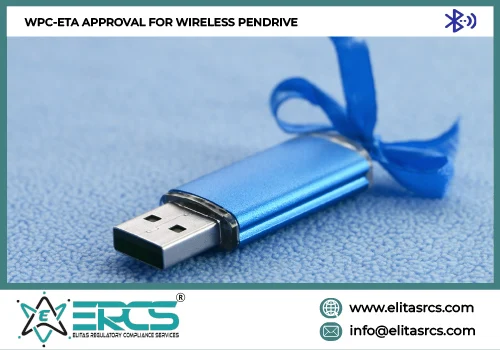WPC Approval (ETA) for
WIRELESS PENDRIVE in India

WIRELESS PENDRIVE
Users are able to transmit data wirelessly between computers using a form of USB flash drive known as a Wireless Pendrive. This eliminates the requirement for users to have a physical connection between the devices. Establishing a wireless connection between the pendrive and the device it is being used with may be accomplished via the use of either Wi-Fi or Bluetooth technologies. When there is no USB port available or when the user is unable to physically connect the pendrive to the device, wireless pendrives are often used as a convenient method through which files moved from one device to another. This is especially true in situations in which the user cannot physically connect the pendrive to the device. Some wireless pendrives come with extra functionality, such as mobile applications that enable users to access and control their files from their smartphones or tablets, and built-in security safeguards that secure important files and data. Some wireless pendrives do not have these additional functions. They are gaining popularity as more people depend on many devices and search for more effective methods to organise and access their digital stuff. This is why they are getting more and more popular.
It is possible for Wireless Pendrives to be subject to other regulatory approvals, such as certification from the Federal Communications Commission (FCC) in the United States or other regulatory bodies that are analogous to the FCC in other countries, despite the fact that they are not subject to WPC (Wireless Power Consortium) approval. The Federal Communications Commission (FCC) mandates that all wireless devices must be put through rigors testing in order to establish that they are up to date with the relevant technical requirements and adhere to the relevant electromagnetic radiation regulations. Before they may be lawfully marketed, wireless pendrives that are sold in the United States are required to get certification from the Federal Communications Commission (FCC). In certain other nations, wireless devices are required to adhere to the rules and guidelines established by the European Telecommunications Standards Institute (ETSI). When acquiring a wireless pendrive, it is essential to verify that the device has been approved for use by the appropriate regulatory authority in your nation or area. This will guarantee that the device satisfies all of the essential requirements for both safety and functionality. Verify if the product in question has been properly certified by looking for certification markings on the product's packaging or on the website of the manufacturer. Alternatively, check with the store or the manufacturer directly.
Basic Requirement to get WPC (ETA) approval
Following requirement should be fulfilled by applicant –
Foreign Manufacturers –
Foreign Manufacturer (Applicant) has to appoint Authorized Indian Representative (AIR).
If Foreign Manufacture (applicant) has the Branch office/Liaison office in India then, they can become an AIR.
Domestic Manufacturer –
The domestic (Indian) Manufacturer can directly apply for ETA and import license without nomination of AIR.
Required Documents
For ETA Certificate –
- Copy of Company Registration /GST registration (For address Verification)
- ID and address proof of authorized person
- Radio Frequency (RF) Test report from any foreign laboratory that is ISO 17025 certified or an Indian laboratory that is NABL approved
- Authorization letter (If authorized person is other than CEO)
- Product technical details
For Import License –
- ETA Certificate
- Purchase order
- IEC Certificate
- Proforma Invoice
What is RF (Radio frequency) test report and how to get it?
RF (Radio Frequency) testing is a method of checking the frequency of radio transmissions to ensure that they are efficiently using the spectrum. In order to achieve maximum efficiency, it is essential to ensure that radio waves in the airspace do not conflict with one another.
Manufacturers/ Importer need to get the RF test report from the ILAC/NABL accredited lab for ETA approval to sell the product in India. If the multiple RF modules contains in the particular product, then the test report of all modules to uploaded to get ETA approval.
Process to get Equipment type approval (ETA) from WPC department:
- Checking EN standard and RF testing from AuthorizedLaboratory
- Documents Preparation
- Application Filing to WPC (Online portal generation)
- Submitting the requisite fee online to Govt.
- Application Scrutinization by WPC
- Grant of ETA Certificate by WPC